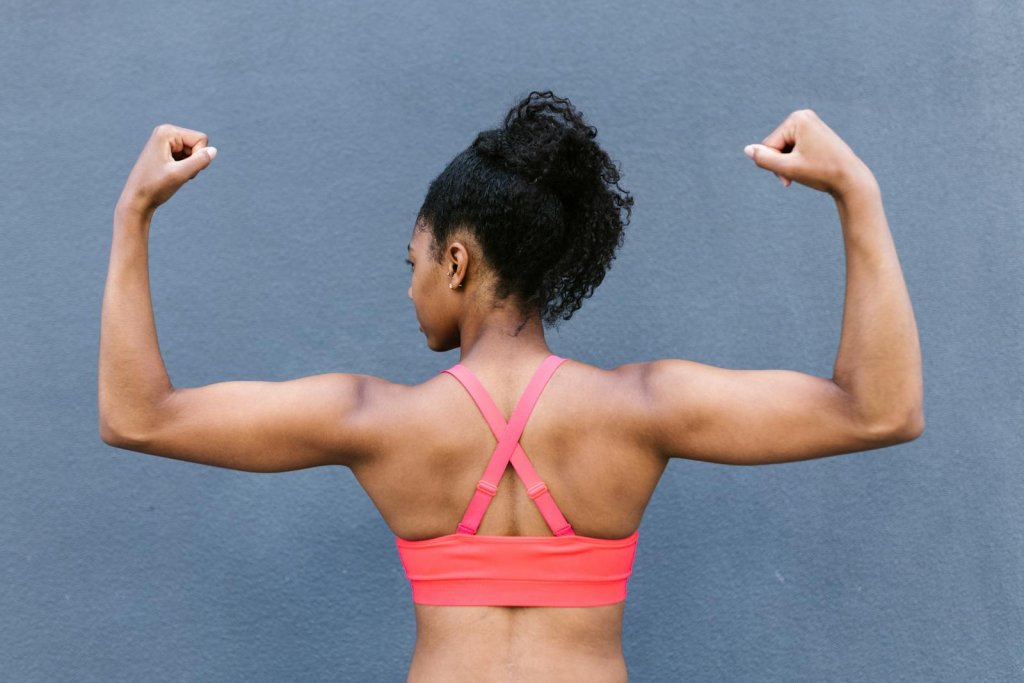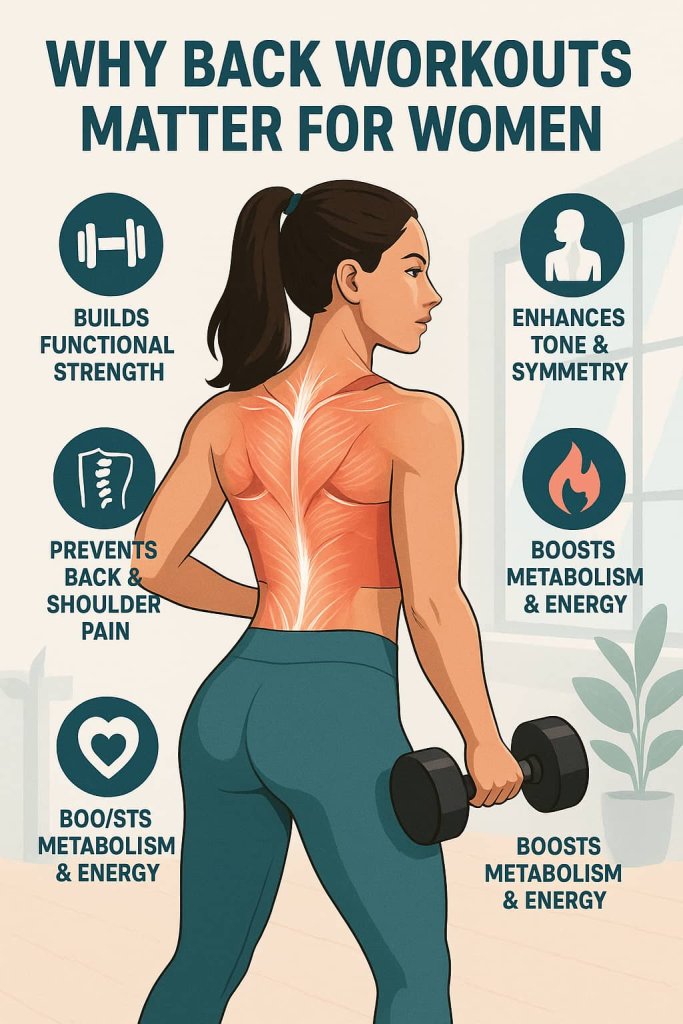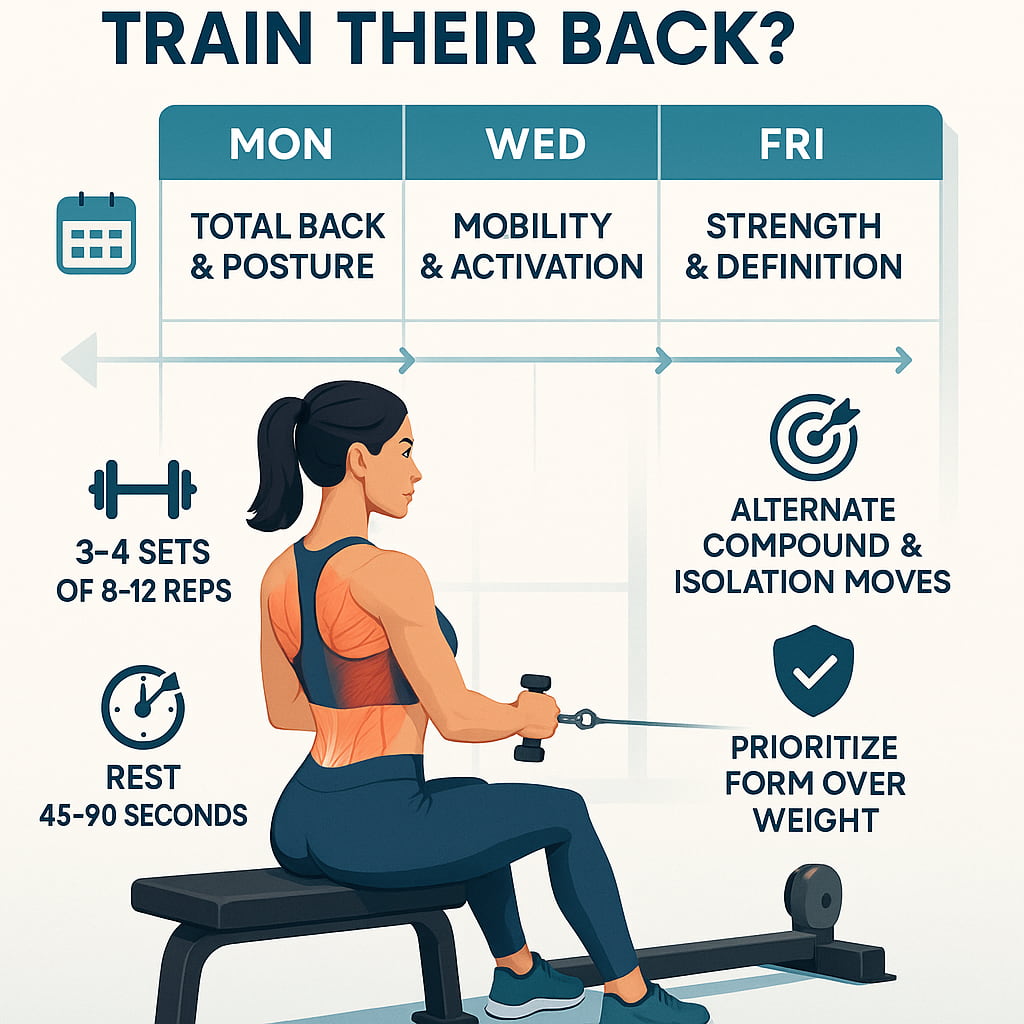Yes — targeted back workouts are essential for women to build strength, correct posture, and achieve a lean, sculpted physique.
A strong back doesn’t just improve aesthetics; it protects your spine, enhances daily movement, and prevents injuries caused by poor posture or muscle imbalances.

In this guide, you’ll learn the 23 best exercises to tone, strengthen, and stabilize your back — whether you train at home or in the gym. Each move focuses on posture, balance, and total-body strength, supported by research from trusted fitness and medical sources.
Why Back Workouts Matter for Women
Research from Harvard Health Publishing (2024) shows that strong back muscles support posture, prevent chronic pain, and improve upper-body strength and stability.
Meanwhile, a Mayo Clinic study found that women who strengthened their back-extensor muscles reduced spinal curvature (thoracic kyphosis) by an average of 2.8°, improving posture and confidence.

Key Benefits:
- Builds functional strength for daily activities
- Improves posture and spinal support
- Enhances upper-body tone and symmetry
- Prevents back and shoulder pain
- Boosts metabolism through larger muscle engagement
How Often Should Women Train Their Back?
According to Harvard Health, train your back 2–3 times per week, alternating between compound and isolation moves.

Suggested Training Split:
- 2 days/week: Total back & posture focus
- 1 day/week: Light mobility & activation
- Sets/Reps: 3–4 sets of 8–12 reps per exercise
- Rest: 45–90 seconds between sets
Trainer Tip: Prioritize form over weight. A controlled range of motion activates the right muscles and protects your spine.
23 Best Back Workouts for Women
Below are the top exercises organized by muscle focus and equipment level.
A. Upper and Mid-Back Workouts
1. Bent-Over Dumbbell Rows
Why it works:
This foundational move builds a strong, toned back by targeting your latissimus dorsi, rhomboids, and rear delts — muscles responsible for posture and pulling power. It mimics everyday actions like picking up objects, improving functional strength and spinal support.
Muscles worked: Lats, rhomboids, rear deltoids, middle trapezius, biceps, and core stabilizers.
How to do it:
- Stand with feet shoulder-width apart, holding a dumbbell in each hand.
- Bend forward at your hips until your torso is nearly parallel to the ground, maintaining a neutral spine.
- Engage your core and let your arms hang naturally.
- Pull both dumbbells toward your ribcage, keeping elbows close to your sides.
- Squeeze your shoulder blades at the top for 1–2 seconds, then slowly lower back down.
Trainer Tip:
Avoid rounding your back. Hinge from the hips, not the waist, and focus on initiating each rep from your back muscles—not your arms.
2. Lat Pulldown
Why it works:
An essential exercise for developing the lats, giving your back its “V” taper and creating a sculpted, feminine upper-body shape. It strengthens pulling movements and improves posture by counteracting tight chest muscles.
Muscles worked: Latissimus dorsi, biceps, traps, rear deltoids, and core stabilizers.
How to do it:
- Sit at a lat pulldown station and grasp the bar with a grip slightly wider than shoulder-width.
- Lean back slightly with your chest up and core tight.
- Pull the bar down to your upper chest while squeezing your shoulder blades together.
- Pause briefly, then slowly return to the start position.
Trainer Tip:
Don’t swing or use momentum — slow, controlled reps create better muscle activation. Keep your elbows driving downward, not backward.
3. Inverted Rows (Body-Weight Rows)
Why it works:
A highly effective body-weight exercise that engages multiple upper-back muscles while improving grip and core stability. It’s ideal for women who want to tone their back without heavy lifting.
Muscles worked: Lats, rhomboids, biceps, traps, and erector spinae.
How to do it:
- Set a barbell in a rack at waist height or use a TRX/suspension trainer.
- Lie underneath and grab the bar with an overhand grip.
- Keep your body straight from head to heels.
- Pull your chest up toward the bar until it touches lightly, then lower yourself down.
Trainer Tip:
Engage your core throughout. To make it harder, elevate your feet or add a weight vest.
4. Seated Cable Row
Why it works:
Perfect for building thickness through the middle back and improving muscle symmetry. This move reinforces postural alignment, helping counteract slouched shoulders common from desk work.
Muscles worked: Rhomboids, traps, lats, rear delts, and biceps.
How to do it:
- Sit on the cable machine with your feet braced and knees slightly bent.
- Hold the handle with both hands and sit tall.
- Pull the handle toward your lower ribs while keeping your torso still.
- Squeeze your shoulder blades together, then slowly extend your arms.
Trainer Tip:
Avoid rocking your body back and forth — isolate the back by keeping your spine tall and core braced.
5. Reverse Fly
Why it works:
This isolation exercise targets the rear delts and upper-back stabilizers, improving posture and shoulder health. It’s particularly valuable for women looking to balance forward-rounded shoulders caused by daily screen use.
Muscles worked: Rear deltoids, rhomboids, traps.
How to do it:
- Hold light dumbbells, palms facing each other.
- Hinge forward at your hips until your chest is almost parallel to the floor.
- With a slight bend in your elbows, raise your arms out to the sides until they’re level with your shoulders.
- Pause, then slowly return to start.
Trainer Tip:
Use controlled movements; avoid swinging. Focus on squeezing your shoulder blades at the top.
B. Lower Back & Core-Support Workouts
6. Superman Exercise
Why it works:
A body-weight classic that strengthens your erector spinae and glutes, enhancing spinal endurance and stability. Ideal for beginners, it supports posture and reduces lower-back pain risk.
Muscles worked: Erector spinae, glutes, hamstrings, shoulders, and core stabilizers.
How to do it:
- Lie face-down with arms extended overhead.
- Simultaneously lift your arms, chest, and legs off the floor.
- Hold the contraction for 2–3 seconds, then lower slowly.
Trainer Tip:
Focus on quality over quantity. Keep the motion small and precise, avoiding strain in the neck.
7. Back Extension (Roman Chair)
Why it works:
Reinforces spinal strength, balance, and endurance. Regular performance helps prevent low-back fatigue during long work hours or lifting activities.
Muscles worked: Erector spinae, glutes, hamstrings, and lower traps.
How to do it:
- Adjust the Roman chair so your hips rest comfortably on the pad.
- Cross your arms or hold a plate to your chest.
- Lower your upper body forward until just below parallel.
- Raise your torso back up until aligned with your legs.
Trainer Tip:
Avoid arching excessively — your body should form a straight line at the top.
8. Bird Dog
Why it works:
A simple yet effective move for improving balance, spinal stability, and coordination. It trains the deep core muscles that support posture and prevent injury.
Muscles worked: Erector spinae, glutes, abs, shoulders, obliques.
How to do it:
- Start on all fours with a neutral spine.
- Extend your right arm and left leg at the same time until parallel to the floor.
- Hold for 2 seconds, return to start, and switch sides.
Trainer Tip:
Keep hips level and avoid rotating your body. Control your breathing for better balance.
9. Deadlift
Why it works:
The ultimate compound lift that strengthens the entire posterior chain — the foundation of power, posture, and movement efficiency. It tones glutes, hamstrings, and back while burning fat.
Muscles worked: Lats, erector spinae, glutes, hamstrings, traps, and forearms.
How to do it:
- Stand with your feet hip-width apart and barbell over midfoot.
- Bend at hips and knees to grip the bar.
- Brace your core, keep chest lifted, and drive through your heels to stand tall.
- Lower the bar slowly while maintaining spinal alignment.
Trainer Tip:
Never round your lower back. Focus on hinging at your hips and keeping the bar close to your body.
10. Good Morning
Why it works:
Strengthens the spinal extensors and hamstrings while teaching proper hip hinge mechanics — crucial for posture and injury prevention.
Muscles worked: Erector spinae, glutes, hamstrings.
How to do it:
- Rest a light barbell or resistance band across your shoulders.
- Keep knees slightly bent and hinge forward at the hips.
- Lower your torso until almost parallel to the floor, then rise back up.
Trainer Tip:
Start light and focus on form. Engage your core and move through a slow, controlled range.
C. Body-Weight & Home Workouts
11. Resistance Band Pull-Apart
Why it works:
An excellent posture-correcting movement that strengthens the rear delts and mid-back muscles — great for counteracting tight chest and rounded shoulders.
Muscles worked: Rear deltoids, rhomboids, traps, rotator cuff.
How to do it:
- Stand tall, holding a resistance band at shoulder height.
- Pull the band apart until your arms are fully extended.
- Slowly return with control.
Trainer Tip:
Maintain constant tension. Keep shoulders down and core tight.
12. Wall Angels
Why it works:
Improves shoulder mobility and flexibility while activating stabilizing muscles in the upper back.
Muscles worked: Rhomboids, rotator cuff, traps, and deltoids.
How to do it:
- Stand with your entire back, head, and arms against a wall.
- Move your arms up and down in a “snow angel” motion.
- Keep your core braced and lower back pressed to the wall.
Trainer Tip:
Focus on slow, controlled movement. This is a posture exercise — not a stretch.
13. Prone Y-T-W Raises
Why it works:
Improves scapular control and posture by strengthening the smaller stabilizer muscles often neglected in women’s training.
Muscles worked: Traps, rhomboids, posterior deltoids.
How to do it:
- Lie face-down, arms extended overhead.
- Lift your chest slightly and form a “Y” with your arms, then lower.
- Repeat with arms in “T” and “W” shapes.
Trainer Tip:
Use light weights or no resistance. Prioritize precision over power.
14. Reverse Snow Angels
Why it works:
Mobilizes the shoulder joint and engages the entire upper back for smoother, pain-free movement.
Muscles worked: Rear deltoids, traps, lats.
How to do it:
- Lie face-down, arms by your sides, palms facing down.
- Lift chest and arms slightly, and move them overhead in a wide arc.
- Return along the same path.
Trainer Tip:
Perform slowly, keeping constant muscle engagement.
15. Plank Row (Renegade Row)
Why it works:
Combines core stability with back activation, enhancing total-body balance and coordination.
Muscles worked: Lats, traps, deltoids, abs, obliques, and core stabilizers.
How to do it:
- Start in a high plank position holding dumbbells.
- Row one dumbbell to your waist while maintaining balance.
- Lower and repeat on the other side.
Trainer Tip:
Avoid hip rotation. Keep your torso square to the floor for maximum core engagement.
D. Machine & Gym-Based Back Workouts
16. T-Bar Row
Why it works:
Develops mid-back and traps thickness, building strength and symmetry through the posterior chain.
Muscles worked: Lats, rhomboids, traps, biceps, erector spinae.
How to do it:
- Stand over the T-bar machine with a neutral grip handle.
- Pull the bar toward your chest, squeezing shoulder blades.
- Lower slowly with control.
Trainer Tip:
Keep elbows close to your sides and avoid overextending your lower back.
17. Assisted Pull-Up
Why it works:
A beginner-friendly way to build the strength needed for unassisted pull-ups while toning the upper back and arms.
Muscles worked: Lats, biceps, traps, rhomboids, core.
How to do it:
- Kneel or stand on the pad of an assisted pull-up machine.
- Grip the handles wider than shoulder-width and pull yourself upward.
- Slowly lower back down.
Trainer Tip:
Reduce assistance gradually to challenge yourself as you get stronger.
18. Chest-Supported Row
Why it works:
Prevents lower-back strain by stabilizing the torso, allowing full isolation of the lats and traps.
Muscles worked: Lats, traps, rhomboids, posterior deltoids.
How to do it:
- Lie chest-down on an incline bench, holding dumbbells or a bar.
- Pull weights toward your ribs, pause, and slowly lower.
Trainer Tip:
Focus on squeezing shoulder blades at the top of every rep.
19. Cable Face Pull
Why it works:
One of the best moves for shoulder health and upper-back balance, reducing risk of rotator cuff injuries.
Muscles worked: Rear deltoids, rhomboids, traps, rotator cuff.
How to do it:
- Set a rope attachment at face height.
- Grip with both hands and pull toward your forehead, flaring elbows outward.
- Return slowly to starting position.
Trainer Tip:
Keep wrists above elbows. Use light weight for perfect form.
20. Hyperextension Machine
Why it works:
Strengthens the erector spinae, glutes, and hamstrings while improving spinal stability and endurance.
Muscles worked: Erector spinae, glutes, hamstrings.
How to do it:
- Adjust pad height and secure feet.
- Lower torso down, then lift until back is straight.
- Avoid arching your spine beyond neutral.
Trainer Tip:
Add a weight plate to your chest for progression.
E. Finisher & Stability Moves
21. Farmer’s Carry
Why it works:
A full-body finisher that enhances grip strength, traps, lats, and core endurance — improving posture and real-world strength.
Muscles worked: Trapezius, lats, deltoids, forearms, core stabilizers.
How to do it:
- Hold heavy dumbbells or kettlebells at your sides.
- Stand tall, shoulders back, core engaged.
- Walk 30–50 feet, then rest and repeat.
Trainer Tip:
Move slowly with control — posture and breathing matter more than distance.
22. Reverse Grip Row
Why it works:
Targets the lower lats and biceps through a unique underhand grip, improving muscle definition and lower-back stability.
Muscles worked: Lats, biceps, traps, rhomboids.
How to do it:
- Hold a barbell with an underhand grip, hands shoulder-width apart.
- Bend slightly at the hips, keeping your torso still.
- Pull the bar toward your waist, squeeze, then lower slowly.
Trainer Tip:
Maintain elbow control and keep bar path close to your body.
23. Stability Ball Back Extension
Why it works:
Enhances balance, spinal endurance, and posture using the instability of a ball for greater muscle activation.
Muscles worked: Erector spinae, glutes, hamstrings, abs.
How to do it:
- Lie face-down on a stability ball, feet braced against a wall.
- Place hands behind your head and lift torso upward until aligned with your legs.
- Lower under control.
Trainer Tip:
Perform slowly — your goal is stability, not speed.
Sample Weekly Back Workout Plan for Women
| Day | Focus | Key Exercises |
|---|---|---|
| Monday | Upper/Mid Back | Lat Pulldown, Seated Row, Reverse Fly |
| Wednesday | Lower Back & Core | Superman, Bird Dog, Deadlift |
| Friday | Full Back & Stability | Bent-Over Row, Plank Row, Farmer’s Carry |
Progression Tip: Add weight or reps every 2–3 weeks to continue building muscle and strength.
Safety & Recovery Tips
- Warm up 5–10 minutes with mobility drills and light cardio.
- Focus on posture: neutral spine, shoulders down, chest open.
- Cool down with stretching for the back, chest, and hamstrings.
- Stay hydrated and rest 48 hours between sessions.
FAQs About Back Workouts for Women
1. Can back workouts make my waist look smaller?
Yes — building your lats creates a “V” shape, enhancing the appearance of a smaller waist.
2. How long does it take to see results?
Within 4–6 weeks of consistent training, you’ll notice improved tone and posture.
3. Do I need heavy weights for results?
Not necessarily. Controlled resistance and proper form matter more than load.
4. Will back training help reduce back pain?
Yes — strengthening spinal muscles supports better posture and reduces pain.
5. Can I do back workouts at home?
Absolutely. Resistance bands, body-weight moves, and light dumbbells are enough to build strength.
6. How should I balance back workouts with other training?
Include them twice weekly alongside chest, leg, and core workouts for total balance.
Conclusion
Strong, well-trained back muscles empower women to move better, stand taller, and feel more confident.
Whether you’re toning, strengthening, or preventing pain, these 23 back workouts will help you achieve lasting results.
Start today — your posture, strength, and confidence will thank you.
References
- Mayo Clinic (2024) — Back exercises in 15 minutes a day
https://www.mayoclinic.org/healthy-lifestyle/adult-health/in-depth/back-pain/art-20546859 - Itoi et al., Mayo Clinic Proceedings (1994) — Effect of Back-Strengthening Exercise on Posture in Healthy Estrogen-Deficient Women (PubMed)
https://pubmed.ncbi.nlm.nih.gov/7967758/ - American College of Sports Medicine (2024) — Resistance Exercise for Health (infographic + evidence summary)
https://acsm.org/resistance-exercise-health-infographic - Hayden et al. (2021) — Exercise Therapy for Chronic Low Back Pain (systematic review)
PubMed: https://pubmed.ncbi.nlm.nih.gov/34580864/
